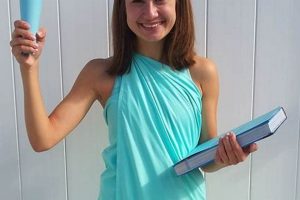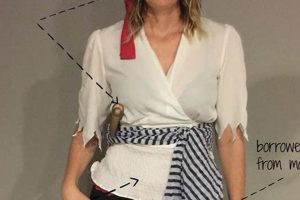Creating a reptilian-themed outfit at home involves the design and construction of attire resembling a crocodile, often utilizing readily available materials and basic crafting techniques. For instance, felt, cardboard, and paint can be combined to fashion a scaled exterior, a toothy headpiece, and a tail, resulting in a wearable representation of the animal.
This form of creative self-expression offers numerous advantages. It provides a cost-effective alternative to commercially produced outfits, fosters resourcefulness and artistic skill, and allows for a personalized and unique appearance. Historically, homemade attire has served as a means of participation in celebrations and performances, reflecting cultural values and individual ingenuity.
The following sections will delve into specific methods for constructing such an ensemble, exploring material choices, construction techniques, and design considerations to facilitate a successful project.
Crafting an Alligatorid-Inspired Ensemble
The creation of a self-fashioned crocodilian outfit necessitates careful planning and execution. Adherence to the following guidelines will enhance the quality and realism of the resulting design.
Tip 1: Material Selection: Opt for durable and lightweight materials. Felt provides a pliable surface for creating scales, while sturdy fabrics like canvas or duck cloth ensure the costume’s longevity. Avoid materials prone to tearing or excessive weight.
Tip 2: Scale Construction: Individual scales can be cut from felt or craft foam and affixed to the costume’s base. Varying the size and shape of the scales adds visual interest and enhances realism. Consider using hot glue or fabric adhesive for secure attachment.
Tip 3: Color Palette: Mimic the natural coloration of crocodilians. Shades of green, brown, and gray, often with subtle variations, contribute to an authentic appearance. Experiment with dry brushing techniques to create depth and texture.
Tip 4: Headpiece Design: A well-constructed headpiece is crucial for capturing the crocodilian likeness. Employ cardboard or foam to create the snout and jaw structure. Consider adding painted details for eyes and nostrils. Ensure the headpiece is securely attached and comfortable to wear.
Tip 5: Tail Implementation: The tail should be lightweight and flexible to allow for ease of movement. Stuffing fabric with batting or foam provides a pliable form. Secure the tail to the costume’s rear using robust stitching or adhesive.
Tip 6: Secure Fastenings: Utilize zippers, Velcro closures, or sturdy ties to ensure the costume remains securely fastened during wear. Reinforce stress points with additional stitching or adhesive.
Tip 7: Movement Considerations: Design the ensemble to allow for a full range of motion. Avoid restrictive elements that impede walking, sitting, or other essential activities. Prioritize comfort and functionality.
By paying attention to these details, a homemade crocodilian-themed outfit can achieve a high degree of realism and durability, ensuring a successful and visually striking result.
The subsequent section will address common challenges encountered during the construction process and offer troubleshooting strategies.
1. Material Selection
The selection of appropriate materials is paramount to the successful creation of a homemade crocodilian outfit. Material properties directly influence the costume’s appearance, durability, comfort, and overall feasibility. The choices made at this stage dictate the achievable level of realism and the lifespan of the finished product.
- Fabric Base Durability
The primary fabric that forms the body of the costume must withstand wear and tear. Materials such as canvas, duck cloth, or heavy felt offer increased resistance to ripping and abrasion. A flimsy base fabric compromises the structural integrity, leading to premature damage and a diminished aesthetic. The selection should reflect anticipated usage and activity levels during wear.
- Scale Construction Material Properties
The material chosen for creating the scales directly impacts the visual texture and ease of application. Felt and craft foam are frequently employed due to their flexibility, ease of cutting, and ability to accept adhesives. Cardboard, while providing a more rigid structure, presents challenges in shaping and attachment. The weight of the chosen material should be considered to prevent excessive burden on the wearer.
- Adhesive Compatibility
The type of adhesive used to attach scales and other decorative elements must be compatible with the chosen fabrics and materials. Hot glue, fabric glue, and contact cement each possess unique properties that affect bond strength and durability. Incompatible adhesives can lead to detachment of components, requiring repairs and potentially compromising the costume’s overall appearance. Testing adhesive compatibility on scrap materials is recommended prior to full-scale construction.
- Colorfastness and Dye Retention
The chosen materials should exhibit resistance to fading and bleeding, particularly if the costume will be exposed to sunlight or moisture. Colorfast fabrics and paints maintain their vibrancy over time, preserving the intended aesthetic. Fabrics with poor dye retention can leach color onto other surfaces or skin, creating undesirable effects and potentially damaging the overall appearance.
The strategic selection of appropriate materials directly impacts the longevity, visual appeal, and wearability of a crocodilian outfit. Failure to consider these factors can result in a costume that is either aesthetically unconvincing, structurally unsound, or uncomfortable to wear, undermining the overall intent of the project.
2. Scale Detailing
Scale detailing represents a critical element in the creation of a convincing homemade crocodilian outfit. The accurate and aesthetically pleasing representation of reptilian scales directly impacts the perceived realism and visual impact of the costume. Inadequate scale detailing can result in a costume that appears cartoonish or lacks the necessary degree of verisimilitude, undermining the overall objective of creating an authentic representation. For example, a costume constructed with uniformly sized and shaped scales, devoid of texture or variation, will likely fail to capture the organic complexity inherent in real crocodilian hides. Conversely, a costume featuring meticulously crafted scales of varying sizes, shapes, and textures, arranged in a pattern that mimics natural scale arrangements, significantly enhances the overall realism. The process of applying scale detailing requires careful attention to detail, employing techniques such as layering, shading, and texturing to create depth and dim
ension.
Practical application of effective scale detailing involves several key considerations. The choice of materials, as previously discussed, significantly influences the achievable level of detail. Felt, craft foam, and even textured fabrics can be employed to create scales. The method of attachment, whether through gluing, sewing, or other techniques, must ensure secure and durable adhesion. Furthermore, the color palette employed in scale detailing plays a crucial role in enhancing realism. Utilizing a range of greens, browns, and grays, often with subtle variations and shading, can create a more nuanced and realistic depiction of reptilian scales. The strategic placement of highlights and shadows can further enhance the three-dimensional effect, adding depth and visual interest to the costume.
In summary, meticulous scale detailing is indispensable for producing a credible and visually impactful crocodilian outfit. Challenges arise in accurately replicating the intricate patterns and textures of real crocodilian scales, requiring patience and attention to detail. However, the effort invested in this aspect of costume construction directly translates into a more authentic and aesthetically pleasing finished product, contributing significantly to the overall success of the project and reflecting broader considerations related to design and craftsmanship in costuming.
3. Color Authenticity
Color authenticity is a significant determinant in the believability of a homemade crocodilian-themed outfit. The visual impact of a costume directly correlates with how accurately its colors reflect those found in nature. Deviations from realistic color palettes diminish the costume’s credibility, resulting in a less convincing representation. For example, a crocodile costume rendered in bright, unnatural greens or blues would immediately detract from the intended effect, regardless of the quality of construction or detailing. Instead, adherence to a range of muted greens, browns, and grays, often incorporating subtle variations and shading, provides a foundation for realism.
The impact of color authenticity extends beyond mere aesthetics. It influences the viewer’s perception of the costume’s overall quality and attention to detail. A carefully researched and executed color scheme demonstrates a commitment to accuracy, suggesting a higher level of craftsmanship and design expertise. In practice, achieving color authenticity involves careful material selection. Dyes and paints should closely match natural color swatches, and techniques such as dry brushing, layering, and shading can be employed to create depth and texture. The interplay of light and shadow on the costume’s surface is also important. Replicating the subtle variations in coloration observed in natural specimens requires careful observation and artistic skill. Consider, for instance, the darker dorsal scales transitioning to lighter ventral scalesan element often overlooked, yet crucial for conveying a sense of realism.
Ultimately, color authenticity serves as a cornerstone of a successful reptilian-inspired outfit. Addressing this aspect with diligence contributes substantially to the overall impact, demonstrating a commitment to detail that elevates the costume from a mere imitation to a more convincing and engaging representation. Challenges may arise in sourcing accurately colored materials or mastering blending techniques, but overcoming these hurdles is essential for achieving a high degree of realism, ultimately enhancing the costume’s overall success and bolstering its credibility.
4. Headpiece Construction
Headpiece construction constitutes a pivotal component within the creation of a homemade crocodilian outfit. The headpiece serves as the focal point of the ensemble, immediately conveying the intended reptilian character. A poorly constructed or disproportionate headpiece can detract significantly from the overall effect, irrespective of the quality of other costume elements. Conversely, a well-crafted headpiece, accurately replicating the snout, jawline, and eye placement of a crocodilian, substantially enhances the costume’s realism. The construction process involves shaping and assembling various materials, such as cardboard, foam, or fabric, to create a three-dimensional representation of the crocodilian’s head. Attention to anatomical accuracy, including the placement and shape of teeth, nostrils, and eye sockets, is crucial for achieving a convincing result. For example, a headpiece neglecting the characteristic placement of the eyes atop the head, common among crocodilians, would immediately appear unnatural and undermine the costume’s authenticity.
Effective headpiece construction necessitates a comprehensive understanding of crocodilian anatomy and the appropriate application of crafting techniques. The selection of materials influences the headpiece’s weight, durability, and ease of construction. Lightweight materials, such as foam, are preferable for comfort during prolonged wear. The structural integrity of the headpiece must be considered to withstand handling and potential impacts. Internal supports or reinforcements may be necessary to maintain the desired shape and prevent collapse. Furthermore, the method of attachment to the wearer’s head requires careful consideration. Adjustable straps or a secure harness system ensures a comfortable and stable fit. Poorly designed attachment mechanisms can result in discomfort, slippage, or even injury.
In summary, the headpiece represents a critical element within the realm of homemade crocodilian costuming. Its accurate construction and secure fit are paramount for achieving a realistic and visually compelling effect. Neglecting this component diminishes the costume’s overall impact, while diligent attention to detail elevates the ensemble from a mere imitation to a more convincing representation of a crocodilian. Therefore, investing time and resources in the design and construction of a well-executed headpiece is essential for achieving a successful and aesthetically pleasing crocodilian outfit, reflecting broader aspects of design and detail in homemade costumes.
5. Tail Attachment
The secure and appropriately designed tail attachment is an integral component of a homemade crocodilian outfit. The tail not only contributes significantly to the visual realism of the costume but also impacts the wearer’s mobility and overall comfort.
- Weight Distribution and Balance
The weight of the tail, often substantial depending on its length and construction, must be strategically distributed to maintain balance and prevent strain on the wearer. A poorly balanced tail can lead to discomfort, fatigue, and even difficulty walking. Proper attachment techniques, such as using a supportive harness or belt system, can effectively mitigate these issues.
- Material Compatibility and Durability
The materials used for the tail must be compatible with the attachment method and durable enough to withstand repeated use. Fabric tails, for example, require robust stitching and reinforcement at the point of attachment to prevent tearing. Rigid tails, constructed from materials like cardboard or foam, necessitate se
cure and well-anchored fasteners to avoid detachment. Glue strength and fabric reinforcement play a huge part here. - Range of Motion and Flexibility
The design of the tail attachment should allow for a reasonable range of motion without compromising the costume’s overall appearance. A tail that is too stiff or rigidly attached can impede walking and sitting, detracting from the wearer’s experience. Conversely, a tail that is too loosely attached may swing excessively or detach entirely. Striking a balance between flexibility and secure attachment is crucial.
- Aesthetic Integration and Realism
The tail attachment should seamlessly integrate with the overall design of the costume, contributing to its realism and visual appeal. The attachment point should be concealed or blended into the surrounding fabric to avoid appearing artificial or disjointed. The tail’s shape, size, and texture should accurately reflect the characteristics of a crocodilian’s tail to enhance the costume’s authenticity. This needs to be thought of when making the crocodile diy costume in mind.
These considerations collectively contribute to the successful integration of the tail within a homemade crocodilian outfit. A well-executed tail attachment not only enhances the costume’s visual appeal but also ensures the wearer’s comfort and mobility, ultimately elevating the overall quality of the creation. These elements are crucial when dealing with a crocodile diy costume.
6. Comfort/Mobility
The successful implementation of a homemade crocodilian outfit hinges significantly on the wearer’s comfort and ability to move freely. These factors directly influence the overall experience and utility of the design, determining whether the costume is merely visually appealing or genuinely wearable.
- Weight Distribution and Wearability
The distribution of weight throughout the costume, particularly in areas such as the headpiece and tail, dictates the wearer’s physical burden. Uneven weight distribution can lead to strain, discomfort, and reduced mobility. For instance, a disproportionately heavy headpiece can cause neck fatigue, while an excessively long or heavy tail can impede walking. Lightweight materials and strategic weight placement are essential considerations in mitigating these issues. The goal is to minimize the physical demand on the wearer, enabling prolonged and comfortable use.
- Range of Motion and Articulation
The costume’s design must permit an adequate range of motion for essential activities such as walking, sitting, and reaching. Restrictive designs can impede these movements, rendering the costume impractical for extended wear or active participation. For example, tightly fitted limbs or a rigid torso can severely limit mobility. Articulated joints and flexible materials are critical for maintaining a functional range of motion. Furthermore, the design should accommodate the wearer’s body type and size to ensure a comfortable and unrestricted fit.
- Ventilation and Temperature Regulation
Adequate ventilation is crucial for preventing overheating and maintaining comfort, particularly during extended wear or in warm environments. Enclosed costumes can trap heat and moisture, leading to discomfort and potential health risks. The incorporation of breathable materials and ventilation openings is essential for promoting airflow and regulating body temperature. For example, mesh panels or strategically placed vents can significantly improve ventilation without compromising the costume’s overall appearance.
- Fastener Security and Adjustability
Secure and adjustable fasteners are necessary for maintaining a comfortable and stable fit. Loose or poorly secured fasteners can lead to slippage, discomfort, and reduced mobility. Adjustable straps, buckles, or hook-and-loop closures allow the wearer to customize the fit and ensure that the costume remains securely in place. Furthermore, the fastener design should minimize the risk of chafing or irritation, particularly in areas of high friction. Secure fit and adjustability are essential for both safety and comfort.
These considerations collectively underscore the importance of comfort and mobility in the design of a homemade crocodilian outfit. By prioritizing these factors, creators can ensure that their designs are not only visually appealing but also practical and enjoyable to wear, enhancing the overall experience for the wearer and reflecting broader considerations about design and wearability within homemade costume creation.
Frequently Asked Questions
The following addresses common inquiries regarding the design and construction of reptilian-inspired attire, providing clarification on key considerations and potential challenges.
Question 1: What are the essential materials for a durable crocodilian outfit?
Durable construction necessitates a combination of resilient materials. A robust base fabric, such as canvas or heavy felt, is essential for withstanding wear and tear. Scale construction benefits from the pliability of felt or craft foam, while secure attachment requires compatible adhesives or strong stitching. The selection should prioritize longevity and resistance to damage.
Question 2: How can a realistic scale texture be achieved on a homemade costume?
Realistic scale texture can be achieved through various methods. Layering scales of different sizes and shapes creates visual depth. Dry brushing or shading techniques can further enhance the three-dimensional effect. Embossing or texturing materials adds tactile realism. Attention to detail is paramount for mimicking the intricate patterns found in natural crocodilian hides.
Question 3: What are effective methods for securing the tail to a costume?
Secure tail attachment requires a robust and well-integrated system. A supportive harness or belt distributes the tail’s weight, preventing strain on the wearer. Stitching, adhesive bonding, or a combination of both ensures durable attachment to the costume’s base. Reinforcement at stress points is crucial for preventing tearing or detachment during movement.
Question 4: How can a headpiece be constructed to ensure comfort and stability?
Comfort and stability in a headpiece are achieved through careful design and material selection. Lightweight materials, such as foam, reduce strain on the wearer’s neck. An adjustable harness or strap system provides a secure and customizable fit. Internal supports maintain the headpiece’s shape and prevent collapse. Ventilation openings prevent overheating and promote airflow.
Question 5: What are the primary considerations for ensuring freedom of movement while wearing a crocodilian costume?
Freedom of movement necessitates a design that accommodates essential activities. Loose-fitting limbs and a flexible torso allow for a full range of motion. Articulated joints at the knees and elbows enhance mobility. The costume should not restrict walking, sitting, or reaching. Prioritizing comfort and functionality ensures a positive wearing experience.
Question 6: How can color authenticity be achieved in a crocodilian-themed outfit?
Color authenticity is achieved by mimicking the natural coloration of crocodilians. Muted greens, browns, and grays form the basis of the color palette. Subtle variations and shading create depth and realism. The use of dr
y brushing or layering techniques enhances the three-dimensional effect. Careful observation of natural specimens provides valuable guidance for accurate color representation.
These FAQs provide a foundation for addressing common concerns. Diligent attention to these aspects enhances the overall quality and realism of a crocodilian-inspired outfit.
The following will explore troubleshooting for common construction errors during the process of making a crocodilian outfit.
Conclusion
The preceding exploration of the “crocodile diy costume” has elucidated essential aspects of its creation, from material selection and scale detailing to headpiece construction and tail attachment. Emphasis has been placed on achieving realism, durability, comfort, and mobility through informed design choices and meticulous execution. An understanding of these principles is paramount for individuals seeking to construct a convincing and functional reptilian-themed ensemble.
Successful application of the outlined techniques demands a commitment to detail and a willingness to overcome potential challenges. The creation of a compelling “crocodile diy costume” represents more than a mere crafting exercise; it embodies a fusion of artistic vision and practical skill. Continued exploration and refinement of these methodologies will undoubtedly contribute to enhanced realism and innovation within the realm of homemade costume design.






![DIY Duo: Mermaid Man & Barnacle Boy Costumes [Easy Guide] The DIY Hub: Creative Crafts, Repairs & Life Hacks DIY Duo: Mermaid Man & Barnacle Boy Costumes [Easy Guide] | The DIY Hub: Creative Crafts, Repairs & Life Hacks](https://craftingdiycenter.com/wp-content/uploads/2025/07/th-7021-300x200.jpg)
